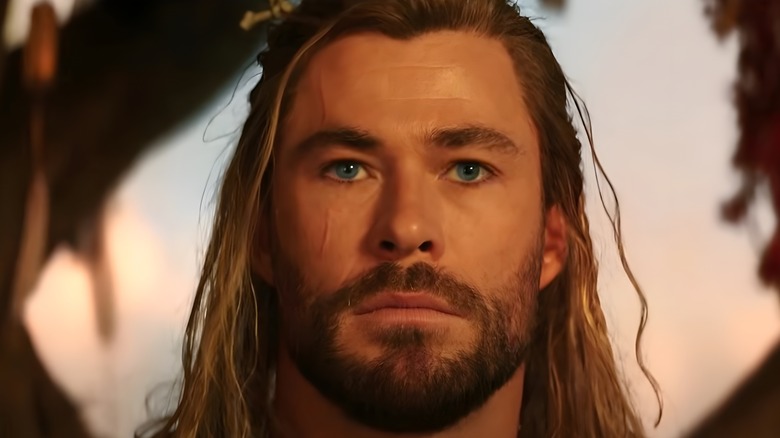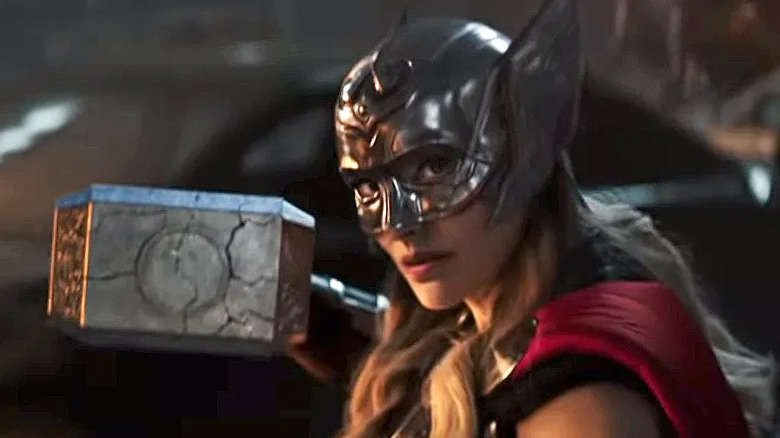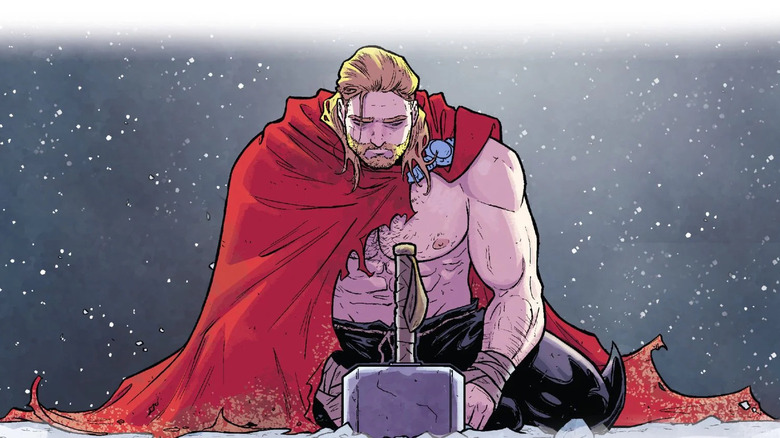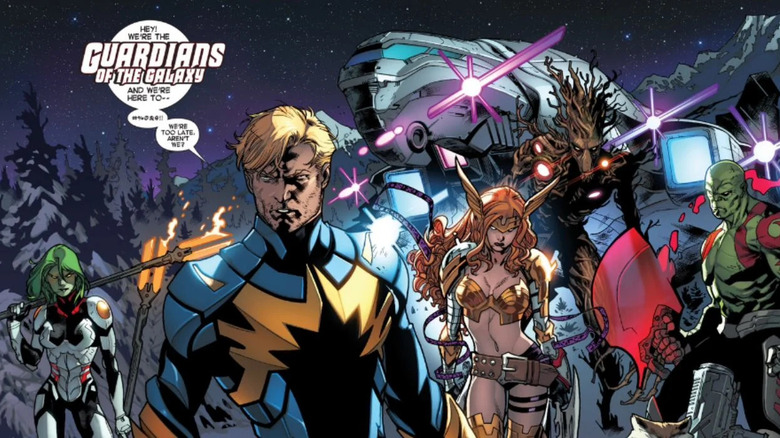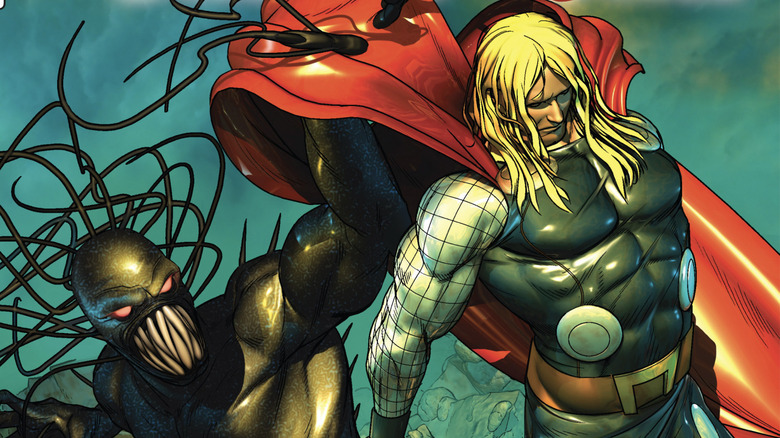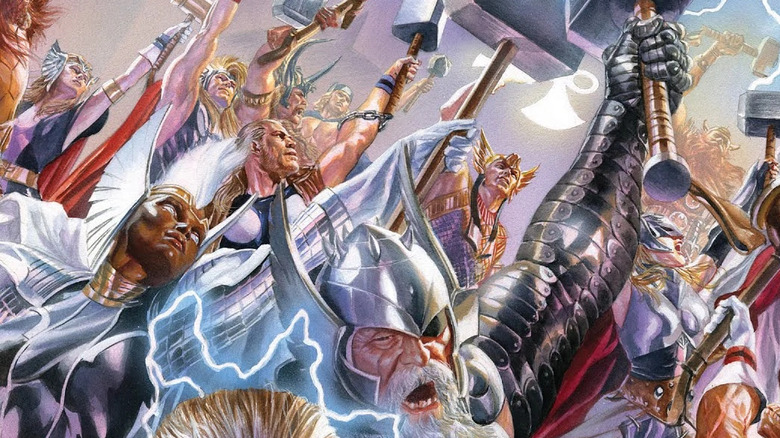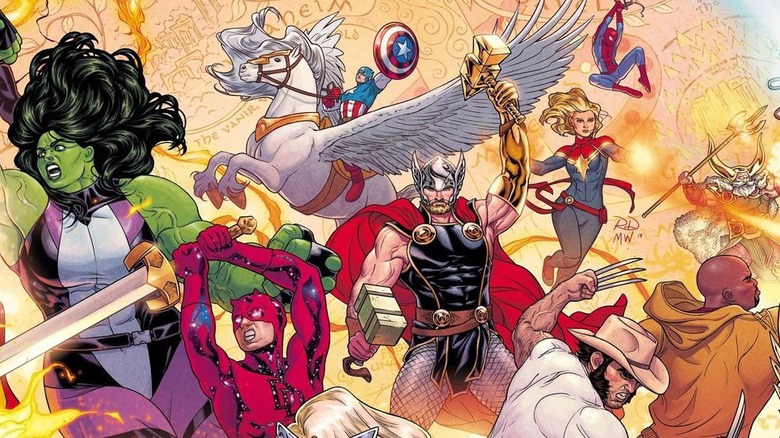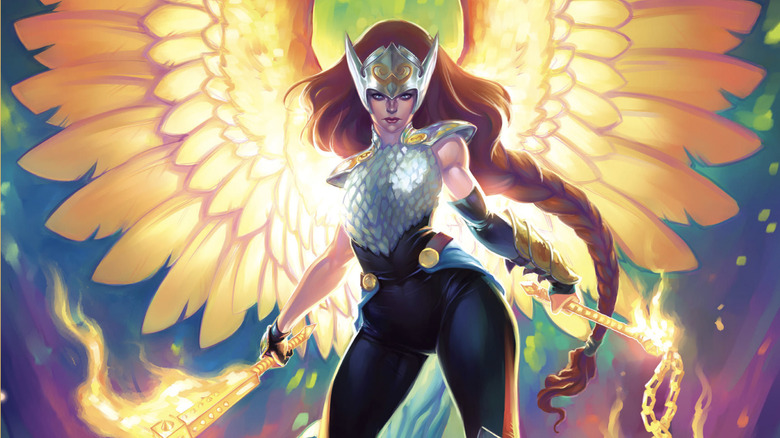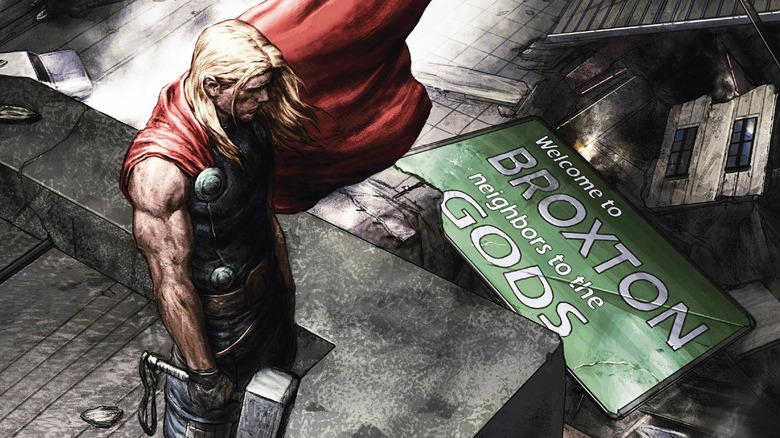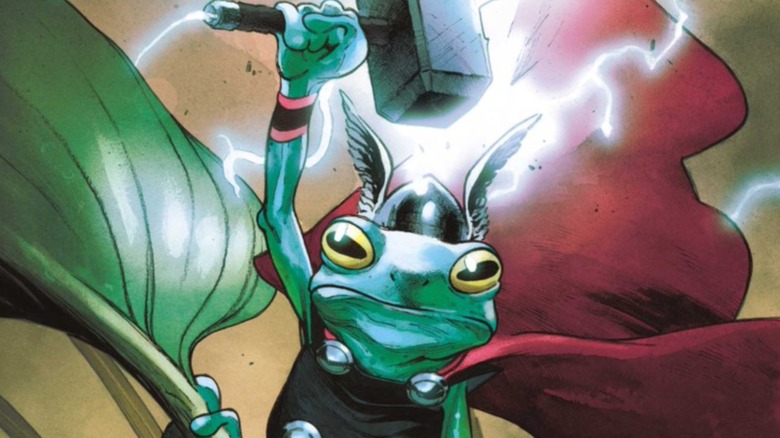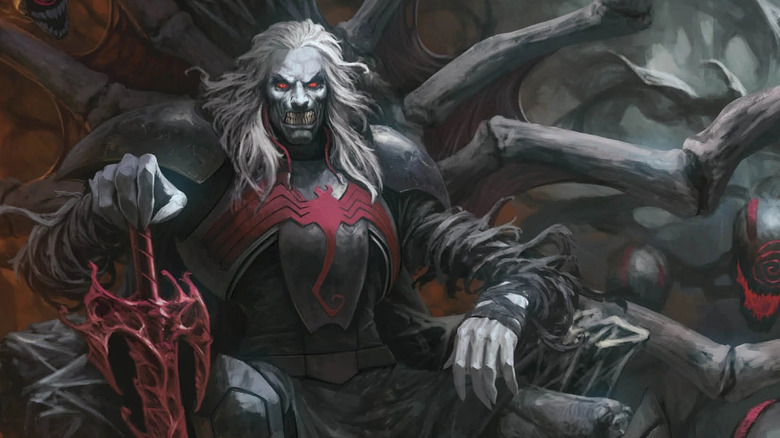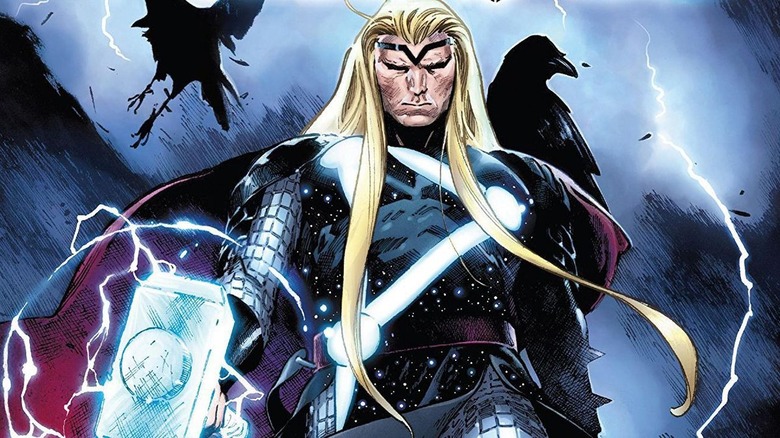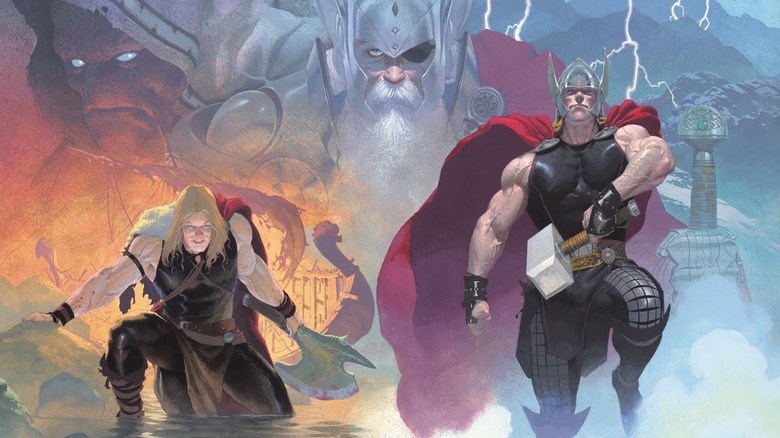Essential Comics To Read Before Seeing Thor: Love And Thunder
After what seemed like an eternity, the first trailer for "Thor: Love and Thunder" dropped on April 18, and it did not disappoint. Within a minute and half the teaser delivers more than enough to keep the God of Thunder's many devotees worshiping at his altar until the film's July 8 release. Between the Guardians of the Galaxy (perhaps more accurately the Asgardians of the Galaxy), the introduction of Marvel's Greek pantheon, and the first look at Jane Foster as Thor, the brief reel promises a story packed to the brim with lore, laughter, and long-awaited wishes come true.
Such a fun spectacle of fan service didn't come from out of the blue, however. For viewers to have long-awaited a moment, it has to have a basis elsewhere -– some previous incarnation, set-up, or tease that planted the seeds of desire in their hearts. With many moments in the Marvel Cinematic Universe, that seed was sown in the pages of the comics. In fact, some astute viewers of the new trailer contend that Marvel has harvested some seeds before they could even blossom into plants. Regardless, Marvel's Thor is a product of his comic run, and some of them make for fascinating reads ahead of the movie's release. Here are twelve of the essential comics to read before seeing "Thor: Love and Thunder."
The Mighty Thor
The name Jason Aaron will appear among these entries often, as it should in any discussion of influential Thor stories. The writer spent around eight years transforming a relatively two-dimensional god into a flawed, tragic, and deeply human character. Nowhere was this dimensionality more apparent than in the Odinson's struggle to understand what it truly means to be worthy. At his lowest point, he found himself utterly unworthy of wielding Mjölnir, so the hammer sought out a new master: Doctor Jane Foster. 2014's "Thor" and 2015's "The Mighty Thor" chronicle the (nearly) complete adventures of Foster as Thor, and likely serve as a central reason why Foster will wield the hammer and wear the title of Thor in the upcoming movie.
As Aaron said while teasing the character, "This is not She-Thor. This is not Lady Thor. This is not Thorita. This is THOR." When Foster picked up Mjölnir she became Thor, and the hunky male version ceded her the designation, choosing instead to go by his last name, Odinson. As Thor took her place as one of Earth's – and Asgard's – mightiest heroes, it quickly became apparent that she was no female copy of her predecessor. Her speed and dexterity dwarfed the Odinson's and made her a feared foe of Earth's enemies.
The Unworthy Thor
While Foster acted as Thor, the Odinson went on his own journeys, most of which centered around his quest for answers and atonement. In "The Unworthy Thor," the Odinson battles throughout the cosmos in his quest to find a replacement hammer only to abandon the search in favor of addressing his deeper issue: how can he reclaim true worthiness, not only by Mjölnir's standards, but by his people's standards and his own.
In an arc almost guaranteed to parallel the events of "Thor: Love and Thunder," the Odinson initially regards the new Thor (at that point still an unnamed blonde mystery woman) with contempt and even aggression. Upon seeing her strength, capability with Mjölnir, and her unquestionable worthiness, the Odinson comes to accept Thor as a tolerable substitute. Eventually, the Odinson realizes the purity of Thor, especially as it contrasts to his own self-doubt, and encourages her to continue on as the one, true Thor. Foster is all too happy to oblige, even refusing to abandon the Thor persona when it becomes apparent that the powers are killing her.
Bendis' Guardians of the Galaxy
In much the same way that Jason Aaron defined most of Thor's modern characterization, writer Brian Michael Bendis provided much of the personality that fans have come to expect from the modern Guardians of the Galaxy. Though his four-year tenure was met with mixed reviews from readers, his character and dialogue heavy approach to the stories helped generate the snarky, bickering, and begrudging family dynamic that the group is now so famous for.
Between his series, which began with 2013's "Guardians of the Galaxy." and his consulting work on the 2014 MCU movie of the same name, Bendis' Guardians have in many ways become the Guardians. They are not to be skipped by anyone excited about Thor joining their ragtag family in "Thor: Love and Thunder."
One feature that may be of particular interest to Thor fans is the writer's addition of the god's long-lost sister Angela to the team's lineup. Angela, born Aldrif Odinsdottir, was added to the team after Marvel acquired the character as the result of a longstanding legal conflict between co-creators Todd McFarlane and Neil Gaiman. When Marvel finally found themselves in control of the Odinsdottir's fate, they chose to place her alongside her fellow cosmic misfits, the Guardians of the Galaxy – just as MCU creative chose to place their rudderless Thor in the same team.
Chaos War
One of the most anticipated moments in "Thor: Love and Thunder" is the introduction of the Greek pantheon into the MCU, and by extension, the implied existence of the rest of Earth's pantheons – even the pantheons of other planets. With Russel Crowe confirmed to play Zeus, the big question on the minds of comic fans is: Will the MCU debut its Hercules?
In the pages of Marvel comics, Hercules has always been a major player in the superhero community, serving on multiple Avengers teams over his long history. Throughout almost every incarnation of the character, Herc has maintained a friendly competition with Thor, the two often challenging each other to feats of strength and sporting combat. With Thor confirmed to visit Olympus in the new movie, as well as meeting with Herc's father, the possibility of a Hercules appearance is tantalizing.
One of the most relevant stories involving the Olympian and Asgardian is the 2010 event "Chaos War," which saw the two gods teaming with a host of other deities (and one Eternal) in order to prevent the Japanese chaos deity Amatsu-Mikaboshi from devouring all of creation. On both his anti-deity rhetoric and amorphous, black form, Mikaboshi serves as a close cousin to the upcoming movie's villain, Gorr.
The Thor Corps
The 2015 event "Secret Wars" saw Doctor Doom in full control of the last remaining vestiges of the multiverse – a patchwork of various planets and timelines known as Battleworld. In order to maintain order in this tenuous reality, Doom gathered the Thors from dozens of different realities and drafted them into his Thor Corps, a police force whose every member wielded a godly thunder.
Although the "Thors" miniseries didn't quite live up to the outstanding quality of the main "Secret Wars" event, it did provide readers with a whole host of alternate-reality Thors. Many fan favorites returned, including Old King Thor, Jane Foster Thor, Ultimate Thor, Beta Ray Bill, and the version of the X-Men's Storm who became a Thor. In addition, a plethora of novel alternate Thors debuted, including a boar Thor and lizard Thor, and the series showed off the possibilities of a multiversal Thor.
Given that "Thor: Love and Thunder" will immediately follow "Doctor Strange in the Multiverse of Madness," and that the MCU's other multiverse-melding series stars none other than Thor's brother Loki, the chance that viewers will soon see an alternate-reality Thor is far from zero.
War of the Realms
There has never been a major Marvel event to place Thor – both Foster and Odinson – more front and center than 2019's "War of the Realms." As its name suggests, the story sees an all out battle for the Nine Realms (actually ten realms by that point, thanks to the inclusion of Angela's homeworld, Heven), one that roped in heroes and armies from every corner of existence. Chief among them was Thor, bent on preserving the safety and order of the realms, and Malekith, the dark elf who wants nothing more than to watch creation burn (and who notably underwhelmed as the antagonist in the 2013 film "Thor: the Dark World").
As excellent as the storyline is throughout, its most relevant moments to the upcoming Thor film all take place at its end. By the close of the War of the Realms, Jane Foster has ceased to be Thor permanently and Odin has officially stepped down as Asgard's king, crowning Thor in his stead. The status quo, from then on, somewhat mirrors the character's current status in the MCU – Odin is gone, Thor is left in charge of Asgard (until he grants it to Valkyrie), and as far as anyone is aware, there is but one Thor.
Valkyrie: Jane Foster
Following the War of the Realms, Foster is no longer Thor. The title was granted to the Odinson once again, alongside Mjölnir and the command of thunder. Foster's days as a superbeing, however, were far from over. After the War led to the deaths of Asgard's entire Valkyrie force, Foster decides to take up the mantle herself, which formed the backdrop of her next comic series, "Valkyrie: Jane Foster."
Depending on how the last act of "Thor: Love and Thunder" goes, Foster's post-Thor occupation in the comics may bear heavily on the MCU. It is still unknown whether or not Foster's Thor will replace the Odinson in the movie, work alongside him for the foreseeable future, or merely borrow the hammer and powers briefly before returning them. Should Natalie Portman's Foster lose her powers by the end of the movie, she may end up following in her comic book counterpart's footsteps and take up the mantle of Valkyrie. Given that Thompson's Valkyrie character looks tied up in bureaucracy during the film, the position may just be open.
Thor in Broxton
As "Avengers: Endgame" concludes, Thompson's Valkyrie is given the title of king of Asgard. She, and not the space-bound and nomadic Thor, will lead the last survivors of Asgard as they reestablish themselves in Norway. From the "Thor: Love and Thunder" trailer, that status continues at least as far as the new film's onset. In the MCU, the resettlement of the Asgardian people to Earth is unprecedented – the proud deities have always had the golden halls of Asgard to provide them with shelter and safety. But in the Marvel comics, the people of Asgard have resettled to Earth before.
In 2007's "Thor," after the cataclysmic events of Ragnarok obliterated Asgard and its people, Thor's first action upon returning to Earth is reestablishing Asgard – as a floating city above Broxton, Oklahoma. This is, of course, a direct parallel to the MCU's Thor deciding to relocate Asgard to Norway after Ragnarok. More than any other series, "Thor" shows the difficulties in maintaining a Heaven on Earth — no doubt similar challenges to those that the MCU's Valkyrie has faced since her ascension in "Endgame." The Asgardians and humans bicker, war with each other, and even find love. Read the series to follow the tragic romance of Asgardian Kelda and Oklahoman Bill.
Asgardians of the Galaxy
In one of the final scenes of "Avengers: Endgame," Thor shacks up with the Guardians of the Galaxy aboard the Milano, jokingly referring to their new team as the "Asgardians of the Galaxy." Though the line functions perfectly well as a simple play on words, it actually is a direct reference to a comic series of the same name. The 2018 run, legitimately titled "Asgardians of the Galaxy," brought together a small squad of Thor-adjacent heroes to form a team whose adventures were equal parts fantasy and cosmic fun. The team consisted of a few familiar faces, including Loki, Thor's sister Angela, the pre-Foster Valkyrie, and even Skurge the Executioner – the same Skurge portrayed by the ever-stellar Karl Urban in 2017's "Thor: Ragnarok."
Given that the MCU's Thor is about to begin his new movie with the Guardians – his self-styled Asgardians – of the Galaxy, the comic series may end up an important read ahead of the film's release. The short series is worth a look even if its events never directly bear on the upcoming movie, as its spirit and tone certainly will. The issues wove sci-fi with the divine, showing the tremendous potential for fish-out-of-water hijinks and the endless, kaleidoscopic possibilities inherent in such a union.
2018 Venom
As surprising as it may be to those who haven't read it, 2018's "Venom" forged a powerful bond between the backstories of Thor and the alien symbiote – one that heavily affects the events of "Thor: Love and Thunder." The series filled in a backstory for the symbiotes, known in the comics as the Klyntar, which began with the primordial deity Knull. The ancient, malicious god created a number of creatures and tools in his quest to extinguish all light from the universe – his most famous creations being the Klyntar race and All-Black, the very sword (and technically a symbiote itself) that Gorr the God Butcher wields in his pogrom against divine beings.
What's more, the Necrosword is almost certainly confirmed to appear in the new movie, again wielded by Gorr, as Marvel leaked when it revealed the official "Thor: Love and Thunder" Lego sets. Venom owes his existence to the ancient machinations of Knull in the same way that Gorr owes his power to the god (which is ironic, considering his anti-god agenda). Given that Venom just made his official MCU debut in "Spider-Man: No Way Home," the timing between his and the Necrosword's first appearances could be more than a coincidence – Knull could just be one of the MCU's next big bads.
The current Thor
There is one major aspect of the "Thor" comics that the MCU has yet to explore, and "Thor: Love and Thunder" may just be the place to do it. Since the end of the "War of the Realms," Thor has been king of Asgard, his acclimation period chronicled in the ongoing "Thor" that debuted in 2020. One major through-line of the current series is Thor's inheritance from Odin – not just the old god's title, but his tremendous magical power as one of Earth's godheads, also known as Skyfathers. Odin's titanic power reserve was always referred to as the Odinforce, and so naturally, it is renamed the Thorforce when Thor inherits it.
With the added power of the Thorforce, the god is now more powerful than ever, even powerful enough to single-handedly slay Galactus. So, the question of the hour is: Did the MCU's Thor also inherit his father's colossal powers? If not, will he in his next solo outing? Or does Foster receive the power, earning her the right to wield Mjölnir? As Thor is about to match might with Gorr, he is likely to be tested in ways as yet unknown in the other MCU movies. The winning edge he needs might come in the form of the Odinforce-turned-Thorforce.
Thor: God of Thunder
If only one comic series could bear the designation of "required reading" ahead of "Thor: Love and Thunder," it would be this one. The 2012 series "Thor: God of Thunder" likely served as a primary inspiration for the new film, introducing the main antagonist -– Christian Bale's Gorr the God Butcher. It is also widely regarded as one of the most beloved Thor runs ever published. In a mere 12 issues, Aaron pushed Thor farther than ever before, pitting him against the unrelenting hate of Gorr.
"God of Thunder" also expanded the Thor mythos, revealing the god to be a member of a vast, intergalactic community of deities from various worlds. For example, he said of Falligar The Behemoth (who has since featured in the above artist credit controversy) that the two had seen each other "barely a hundred years ago. We passed one another in the spaceways and waved." In the series, three Thors of different ages – young Viking Thor, modern Avenger Thor, and Old King Thor – unite to defeat Gorr, lest the evil figure detonate the "Godbomb" that would wipe all divinity from existence.
